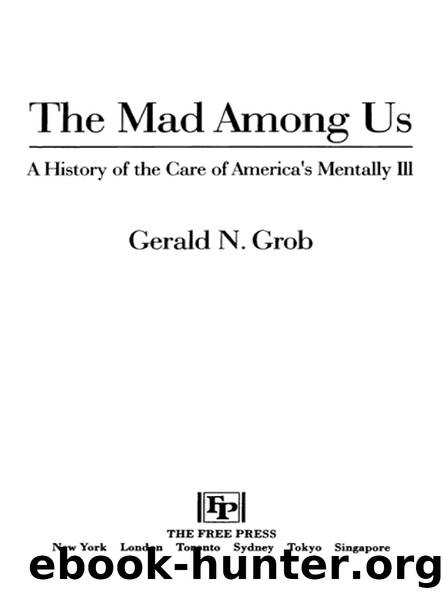The Mad Among Us by Gerald N. Grob

Author:Gerald N. Grob
Language: eng
Format: epub
Tags: SOC035000
Publisher: THE FREE PRESS
Published: 1994-07-15T00:00:00+00:00
Many psychiatrists left military life convinced of the need for fundamental changes in the ways in which the needs of mentally ill and psychologically troubled individuals were addressed. Social and medical innovation, however, required an effective organization capable of translating concepts into practice. The APA, which was the oldest medical specialty association and had just celebrated its centenary, was the obvious choice. Yet in 1945 the APA still represented the interests of hospital psychiatry and an older more somatically oriented tradition. More importantly, it was relatively inactive; its two main functions were to hold an annual convention and to publish the American Journal of Psychiatry. It lacked a salaried leader, an efficient staff, and a secure financial foundation, and its elected officers rarely devoted much time to its affairs.
Dissatisfaction surfaced in early 1944 when a committee recommended that the APA modernize its structure and establish a central headquarters under the direction of a qualified psychiatrist. The APA Council (the highest governing board) then created a Special Committee on Reorganization chaired by Karl A. Menninger. Born in 1893 in Topeka, Kansas, Karl received his M.D. from the Harvard Medical School and subsequently studied with E. E. Southard at Boston Psychopathic Hospital. He returned to Topeka and entered a partnership with his father that within a few years had been transformed into the Menninger Clinic. Joined by his brother William, the two soon made Topeka into one of the nation’s premier psychiatric centers; in the two decades following the end of World War II it became the leading training center of psychodynamic psychiatrists. Karl’s interests were extraordinarily broad. He became the popularizer of psychoanalytic psychiatry through such best-selling books as The Human Mind (1929), Man Against Himself (1938), and Love Against Hate (1942). Possessed of a domineering and charismatic personality, he was a source of controversy until his death in 1990. By contrast, his younger brother William was generally beloved by his colleagues and became the acknowledged national spokesperson of American psychiatry until his death in 1966. Most of those who worked for and with Karl developed a love-hate relationship. Indeed, his fellow psychiatrists never elected him to the presidency of the APA (a post held by many lesser figures), largely because they feared the consequences of his unpredictable behavior. His selection as chair was thus somewhat surprising. 13
Although the Special Committee on Reorganization operated in an open and democratic manner, it was clear that the majority of its members were sympathetic to a psychodynamic point of view. Rumors began to circulate that the Special Committee was dominated by a small group bent on seizing control of the Association. Clarence B. Farrar, the respected editor of the American Journal of Psychiatry, feared that the appointment of a permanent medical director—as contrasted with an elected president—created the possibility of a “dictatorship” and development of a “potential bureaucracy.” The goal of reorganization, he added, was “domination by this radical sectarian group.” William L. Russell, long associated with the New York Hospital, expressed the view
Download
This site does not store any files on its server. We only index and link to content provided by other sites. Please contact the content providers to delete copyright contents if any and email us, we'll remove relevant links or contents immediately.
The Art of Thinking Clearly by Rolf Dobelli(10210)
The 5 Love Languages: The Secret to Love That Lasts by Gary Chapman(9585)
Mindhunter: Inside the FBI's Elite Serial Crime Unit by John E. Douglas & Mark Olshaker(9186)
Becoming Supernatural by Dr. Joe Dispenza(8119)
Nudge - Improving Decisions about Health, Wealth, and Happiness by Thaler Sunstein(7613)
The Road Less Traveled by M. Scott Peck(7522)
Enlightenment Now: The Case for Reason, Science, Humanism, and Progress by Steven Pinker(7228)
Mastermind: How to Think Like Sherlock Holmes by Maria Konnikova(7222)
Win Bigly by Scott Adams(7094)
The Way of Zen by Alan W. Watts(6504)
Factfulness: Ten Reasons We're Wrong About the World – and Why Things Are Better Than You Think by Hans Rosling(4691)
The State of Affairs by Esther Perel(4634)
Gerald's Game by Stephen King(4571)
Man's Search for Meaning by Viktor Frankl(4420)
The Confidence Code by Katty Kay(4187)
Thinking in Bets by Annie Duke(4152)
The Healing Self by Deepak Chopra(3473)
Hidden Persuasion: 33 psychological influence techniques in advertising by Marc Andrews & Matthijs van Leeuwen & Rick van Baaren(3472)
The Worm at the Core by Sheldon Solomon(3430)
